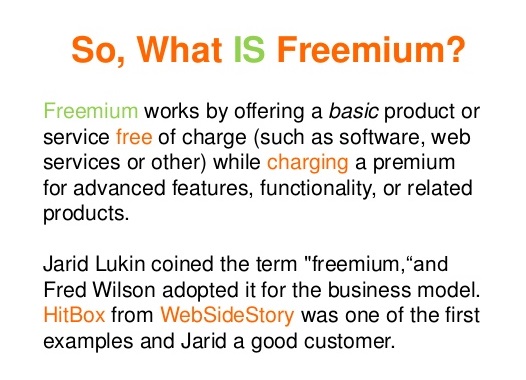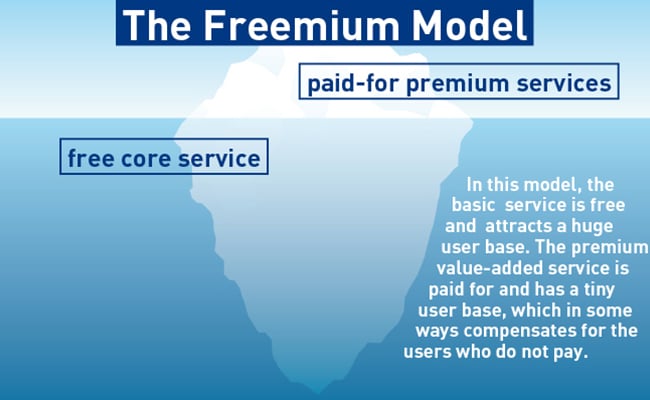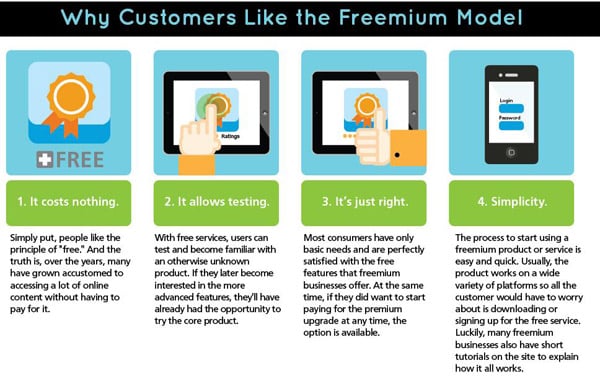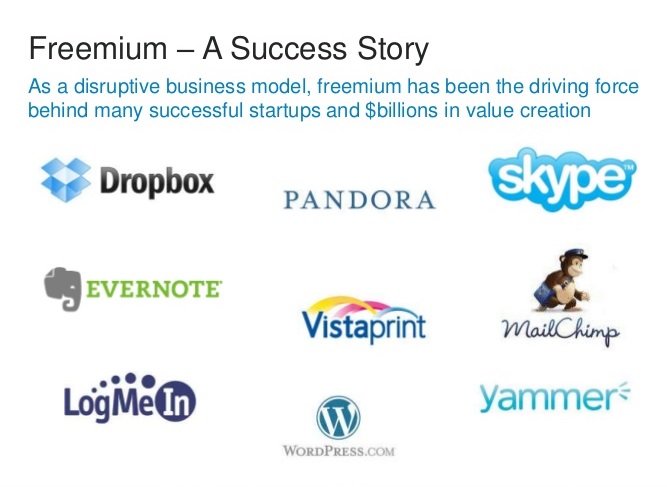There are several revenue models available to monetize your app. Freemium is one of them. It is one of the most popular ways but it is not for everyone. Let’s look at Freemium closely and try to find out what makes it tick.
The words “Free” and “Premium” combine to make “Freemium”. In Freemium revenue model, the app is offered for free to users but certain features are gated or blocked and the users need to pay a certain amount to get those features unlocked. Basic functionality of the app is free but there is a charge for premium and proprietary features.
The truth is, anything useful offered for “Free” attracts users. Freemium model of monetization tries to gather as many users as it can by showcasing the basic features of the app. The idea then is to keep the users engaged and enticed enough so that some of them go for the premium experience of the app by paying more to the publishers. Many enterprise apps which have subscription based businesses choose this approach of monetization and have healthy and sustainable revenue stream.
Most successful gaming apps have adopted this revenue model. Angry Birds, Clash of Clan and Kim Kardashian’s Hollywood Game – all of them gave away their basic version to users for free. If the user wanted premium options or additional levels, they were later unlocked at a price. If you are using any of the services from Pandora, LinkedIn, MailChimp, or SurveyMonkey, you are using a service that uses the Freemium Strategy.
Why Freemium Works?
Freemium works because free works. Users are attracted to the service, they get familiarized to the app at their pace. They slowly discover what they like about the app. They discover the basic functionalities. If it is a game, they pick up basic techniques and moves of the game. Basic tutorials are provided by the app publishers so that users grasp the functionalities the right way. If they like what they see, they tell about the service or the app to their friends, share details on social networks. There is free word of mouth publicity for the new entrant in the town. The app gets users time and attention for free. There is a buzz. The user base slowly increases. More and more people join the flock as the word spreads.
This disruptive model works best for digital products and services because the marginal cost is low. The cost of producing and distributing a product to 10 users and 10 million users remains the same. Thus, a core product can be given away for free and a profitable business can be created by up-selling to a few percentage of users.
It is very good strategy in a competitive market. Being able to try the product before buying it, helps seed the initial market. There is very low user acquisition cost. You can lure users from competitors without spending much on it.
You give away your core product for free and then slowly you find that critical mass of users who love your app and are willing to pay for premium services and full versions. They want the best experience that the app can provide. It all slowly falls into place.
How do you reach your goals with Freemium?
If you have chosen the freemium strategy for your app, let’s look at a few pointers to ensure it proves to be a successful one for you.
#Right offering for right reasons
One way to succeed is to tap the customer segment that is underserved by existing providers – where a product or service is not delivered in an ideal way. Or you need to spot a gap in the services and products being provided and leverage it. No matter how interesting your app idea based on your hobby or a passion is, if you want it to make money, ensure that it adds value. It should either help people and companies make money or it should somehow add value to their life like health and fitness apps, music apps and dating apps do.
If you are creating a new market with a totally new offering, trust your freemium strategy – it will gather right users for you.
#Use Free Features as Marketing Tools
Think clearly before segregating the features of your product for free and paid users. The features you offer for free should work as marketing tools for you. You and your users should try to create a buzz using those features. When you launch a product you should aim at generating excitement around your product or service. Try to gather as many users as you can.
#Make Your Free Users Your Evangelists
Free users are valuable. Once they start using your app some of them fall in love with it and become premium users and others start spreading the word about your app. They become your evangelists and get more users. How do you help your evangelists? Have a special content strategy targeted at them. You can have referral incentives for them. Your happy, satisfied and free customers can help your app go viral. Use and leverage the opportunity smartly.
#Give Users a compelling reason to Upgrade
Users are smart. They need a good reason to upgrade. If your free version is too good and is meeting all the basic needs of your user, he will see no reason to go for paid premium version. You need to strike the right balance. You have to make sure you aren’t giving away too much for free. You need to segment users and features in such a way that you provide value to both – paid and free users. Ning a network of social networks offered almost all its core advantage for free. There was no incentive for users to be its paying user. It didn’t survive.
#Make sure the customer knows the benefits of being a paid customer
This point cannot be emphasised enough. You need to tell the customer clearly in unambiguous terms the advantages of being a paid customer. Ensure that he understands the details of premium features he would get access to. Your content strategy can help you drive this point home.
You need to segregate your customers into different segments based on their extent of engagement with your app or service. You need to have different strategies for different groups. You may need to pace your messages, provide cues and gather feedback at regular intervals to this group to ensure that they see the value in the limited free version and are interested in the benefits full version can provide.
#Stay committed to innovation
You should not use Freemium only as a customer acquisition tool. For your app or service to thrive, you need to stay committed to innovating and making your product better, both paid and free version of it – all the time. If after acquiring significant number of users with free version of your service, you stop paying attention to them, you lose the gained advantage. Ravio, the app publisher of Angry birds keeps its free users glued to the game by providing free updates, and new free versions. Users pay for the new premium features the game routinely develops and sends out to its users. Constant updates and innovation keeps the users engaged.
#Guide potential buyers gently down the funnel
You need to segregate users as cleanly as possible. It would save you from wasting your energies and resources on users who most definitely aren’t inclined to pay for your services. You need to focus on the group that is engaging with your app and services well. This is the group that understands your product and if guided well into the sales funnel, you could see reasonable amount of conversions –the paying users. Ensure you have clear, effective calls to action in place to drive conversion. Deliver free service or free content that solves an important problem in part. Tempt them with full solution. Tell them how good the complete solution is with the help of case studies and testimonials. Invest in seamless migration strategy.
#Track your numbers
It is very important to track the right metrics and right numbers to ensure you stay on the path. You have to make efforts to keep your marginal cost down. You need to ensure that the cost to serve free subscribers is minimized. Your customer acquisition cost should be low. There need to be enough conversions from free to premium to keep you in business. If you want to use the Freemium business model, you would need to keep your cost of operation low to be sustainable. If you are targeting a smaller market you can aim at higher conversion rate. If your market is big smaller percentage of conversion will be reasonable. Important metrics to track are CFU – Cost per Free User, RPU – Revenue per Paying User, DAU – Daily Active User and CR- Conversion Rate amongst others.
Basic Types Of Freemium
Some of the basic type of freemium restrictions are as follows:
Gated Features: Basic version is free, sophisticated version is paid. For example, Evernote basic which is free has very few features when compared with the other versions of Evernote like Evernote Plus and Evernote Premium. Slack and Skype also have gated features.
Time Limited: The service is free for X days, then user pays. Example, Apple Music which is free for first 3 months, after that chargeable. Basecamp provides 30 day free trial on all accounts.
Limited by number of persons: Free for X number of people, any number over X have to pay. For example, Aasana the business app is free for teams of less than 15 members. If there are more than 15 members, the users would need to buy the paid version.
Limited by Customer Type: Autodesk apps are free for all students, other users have to pay.
Limited by storage capacity: Dropbox, the cloud storage and file sharing company provides 2 GB of free storage to everyone. If one needs more, they can pay and get more storage capacity.
Paywall, Limited by number of articles read: NY Times.com, the digital newspaper provides 10 articles a month free to everyone. To read more than 10 articles a month one needs to subscribe and become a paid member.
Depending on the product, app developers can thus formulate their own freemium restrictions.
The Wrap
Freemium is a good disruptive marketing strategy. You don’t need a huge marketing budget but you do need a big infrastructure to serve a big mass of users. The adoption of Freemium model in apps, products and services is rapid. Attention is generated with the free product to sell premium products. It is a win-win situation for both app publishers and users. Users get to try the app for free and app developers get a large group of users which helps in rapid iterations and testing for better UX/UI. Generally only a small percentage of the free users upgrade to paid premium service but it is not a problem as long as it is a small percentage of a large user group – the business remains viable, sustainable and profitable. Traditional marketing strategies are evolving to include new marketing strategies like freemium. As they say now – if you are not using free, you would be competing with free. Freemium is here to stay. We, at OpenXcell can help you with right app marketing strategy. Give us a call to know more.













